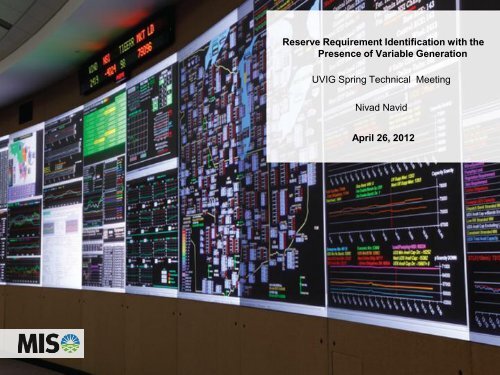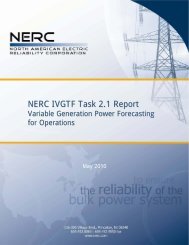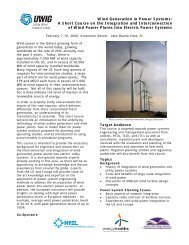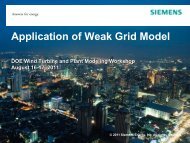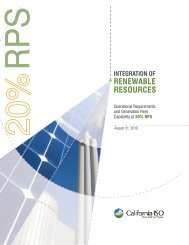How We Do It in MISO
How We Do It in MISO
How We Do It in MISO
You also want an ePaper? Increase the reach of your titles
YUMPU automatically turns print PDFs into web optimized ePapers that Google loves.
Reserve Requirement Identification with the<br />
Presence of Variable Generation<br />
UVIG Spr<strong>in</strong>g Technical Meet<strong>in</strong>g<br />
Nivad Navid<br />
April 26, 2012
Regulation<br />
• <strong>MISO</strong> Regulation Requirements<br />
– <strong>MISO</strong> requirement is a bidirectional value vary<strong>in</strong>g between 300<br />
MW to 500 MW depend<strong>in</strong>g on load level and time of the day<br />
• Impact of Variable Generation<br />
– In general is little to none<br />
– W<strong>in</strong>d Generation can impact the net load variability and<br />
uncerta<strong>in</strong>ty<br />
• One m<strong>in</strong>ute w<strong>in</strong>d generation variation has very little impact on net<br />
load one m<strong>in</strong>ute variability<br />
• Standard deviation of Short-term w<strong>in</strong>d generation forecast error is<br />
between 0.5% to 1% of w<strong>in</strong>d generation capacity<br />
• The impact of short-term w<strong>in</strong>d forecast error <strong>in</strong> net load uncerta<strong>in</strong>ty<br />
is low<br />
2
Cont<strong>in</strong>gency Reserve(s)<br />
.<br />
• <strong>MISO</strong> Cont<strong>in</strong>gency Reserve Requirement<br />
– Criterion: largest generation unit / unit + transmission corridor<br />
– <strong>It</strong> is set to 2000 MW<br />
– Approx. 50% is set as sp<strong>in</strong>n<strong>in</strong>g reserve<br />
– The rest is the supplement reserve (provided by on-l<strong>in</strong>e and offl<strong>in</strong>e<br />
resources <strong>in</strong>clud<strong>in</strong>g Demand Response Resources)<br />
– Due to the deliverability issues there are zonal requirements<br />
• Up to seven zones<br />
– Ma<strong>in</strong> Characteristics of the Cont<strong>in</strong>gency Event<br />
• Occur very quickly (seconds)<br />
• Needs to be compensated <strong>in</strong> 10 m<strong>in</strong>utes<br />
– Current RTO / ISO practice does not use the cont<strong>in</strong>gency<br />
reserve for other shortages <strong>in</strong> the system<br />
3
Cont<strong>in</strong>gency Reserve(s) – Cont’d<br />
.<br />
• Impact of Variable Generation<br />
– None. Unless a s<strong>in</strong>gle w<strong>in</strong>d farm is exceed<strong>in</strong>g the current 2000<br />
MW (system wide) or zonal requirement<br />
– Forecasted w<strong>in</strong>d generation (and / or actual w<strong>in</strong>d generation)<br />
variability has its own latency much longer than a cont<strong>in</strong>gency<br />
event<br />
• <strong>MISO</strong> has experienced loos<strong>in</strong>g w<strong>in</strong>d generation <strong>in</strong> the magnitude of<br />
6000 to 7000 MW <strong>in</strong> about 8 hours (majority of these drops were<br />
forecasted) – In opposite direction to the load variation<br />
• W<strong>in</strong>d generation variation of +/- 2000 MW <strong>in</strong> 20 m<strong>in</strong>utes (rare<br />
events)<br />
4
Market Systems and Applications<br />
DAM<br />
F<strong>in</strong>ancial Market<br />
FRAC<br />
IRAC<br />
Look Ahead<br />
LAC<br />
LAD<br />
Physical Market<br />
AGC<br />
DAM<br />
FRAC<br />
IRAC<br />
LAC<br />
LAD<br />
AGC<br />
Day Ahead Market<br />
Forward Reliability Assessment Commitment<br />
Intra day Reliability Assessment Commitment<br />
Look Ahead Commitment<br />
Look Ahead Dispatch (Currently UDS)<br />
Automatic Generation Control<br />
5
Fundamental Issue<br />
.<br />
• No <strong>in</strong>crease <strong>in</strong> the conventional reserve requirement<br />
• What is the most challeng<strong>in</strong>g issue <strong>in</strong> the day to day<br />
operation<br />
– Ramp<strong>in</strong>g Capability<br />
• Keep<strong>in</strong>g enough rampable capacity <strong>in</strong> the system to go after the net load<br />
variability and uncerta<strong>in</strong>ty<br />
– Enforc<strong>in</strong>g system wide Ramp Up and <strong>Do</strong>wn capacity constra<strong>in</strong>ts <strong>in</strong> the<br />
Day Ahead process (partly cover<strong>in</strong>g <strong>in</strong>tra-hour ramp requirements)<br />
– Intra Day RAC process updates commitment of the generation<br />
resources to make sure upon changes <strong>in</strong> the system conditions there is<br />
enough headroom <strong>in</strong> the system<br />
– Follow<strong>in</strong>g the ramp needs close to the real-time and committ<strong>in</strong>g fast<br />
start up units if needed<br />
– Enforc<strong>in</strong>g an offset value <strong>in</strong> the dispatch function partly to enforce<br />
specific position<strong>in</strong>g of the units<br />
6
Recent and Planned Enhancements<br />
• LAC Phase I <strong>in</strong> the production system<br />
– Ability to have automated near real-time commitment decisions<br />
– On-l<strong>in</strong>e system study<br />
– Intra-hour Commitments / decommitments<br />
– Transmission System constra<strong>in</strong>t analysis<br />
• LAC Phase II and LAD<br />
• Ramp Products<br />
– Under <strong>in</strong>vestigation
Ramp Products - Bus<strong>in</strong>ess Drivers<br />
• Aid reliable operations by keep<strong>in</strong>g sufficient ramp<br />
capability available for use <strong>in</strong> RT dispatch<br />
– Manage System Flexibility<br />
• Incentivize resources to provide ramp capability to be<br />
used <strong>in</strong> the real time market<br />
• Ensure price volatility <strong>in</strong> Real Time is less impacted by<br />
transitory ramp shortages and reflects true market<br />
economics<br />
• Ensure reliable and economical operation <strong>in</strong> the presence<br />
of renewable resources and the potential impacts<br />
associated with the EPA mandates<br />
8
Ramp Products - Methodology<br />
• The Up Ramp Capability and <strong>Do</strong>wn Ramp Capability<br />
products that enable creation of additional rampable<br />
capability to better meet variable net load<br />
– Extends the concept of Headroom/Ramp Constra<strong>in</strong>ts currently<br />
implemented <strong>in</strong> Day Ahead Commitment function<br />
• Ramp Capability Requirements <strong>in</strong> Real Time will<br />
address both observed variations <strong>in</strong> forecasted NSI,<br />
load and renewable generation and also uncerta<strong>in</strong>ty<br />
due to forecast errors<br />
• Ramp Capability Requirements <strong>in</strong> Day Ahead market<br />
will fulfill anticipated ramp capability needed <strong>in</strong> Real<br />
Time<br />
9
Ramp Products - Payments and Charges<br />
• Pric<strong>in</strong>g<br />
– Dispatch solutions produces Ramp Capability clear<strong>in</strong>g prices for the<br />
<strong>in</strong>cremental cost of additional Ramp Capability products<br />
– Prices <strong>in</strong>clude opportunity costs and demand curves if not fully cleared<br />
• Payments<br />
– Similar to AS products<br />
– Awarded Ramp Capability is paid product clear<strong>in</strong>g price<br />
• Charges<br />
– Similar to AS products<br />
– Load charges are <strong>in</strong>creased to compensate for Ramp capability<br />
payments to resources however reduced scarcity pric<strong>in</strong>g decreases<br />
load payments (caus<strong>in</strong>g an overall production cost sav<strong>in</strong>g)<br />
10
Questions <br />
11


